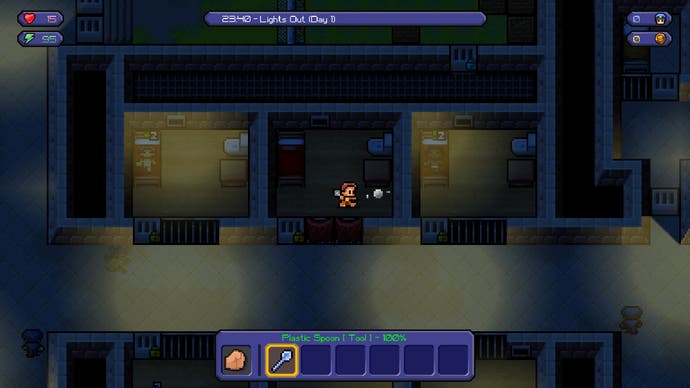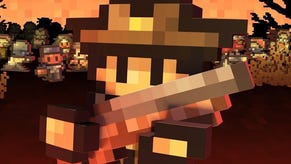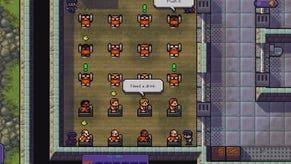The Escapists review
Cell out.
Eurogamer has dropped review scores and replaced them with a new recommendation system. Read the editor's blog to find out more.
Over the last decade, the boundaries of sandbox gaming have been continually pushed back. Not just in terms of physical space, but in terms of the rules governing what you can do in virtual spaces. In the original Driver, the cops would give chase if you went over the speed limit. In Grand Theft Auto 5 you can careen through Los Santos like a tipsy maniac and barely draw any attention.
The Escapists is a sandbox game, but it's one that understands that for freedom to have value there must be edges by which to define your transgressions. To do so, developer Mouldy Toof Studios has opted for the perfect setting: prison.
You're banged up and, as per the title, your goal is to break out. How you do that is up to you, but you must confine your plots and plans within a rigid daily schedule designed to keep you in line. There's morning roll call, then breakfast. You're expected to work at one of several jobs during the day, while exercise and showers are mandatory. There are a couple of blocks of free time during which you're left to your own devices, but even then the places where you can and can't go are firmly policed.
It's this claustrophobia which makes the sandbox sing. Where's the thrill in doing what you want, if everything is open to you? When you break the routine in The Escapists, it's a genuine thrill. You get that tingle in your belly that you got at school when you were roaming the corridors while everyone else was in classrooms.

Indeed, school is not a bad analogy, since it seems pretty clear that somebody at Mouldy Toof is a big fan of the ZX Spectrum classic Skool Daze. The Escapists has much the same structure, albeit with guards instead of teachers, hard labour instead of science lessons and solitary confinement instead of lines. In case the parallels weren't clear enough, you can even rename the guards and inmates before play, just as Microsphere's educational romp allowed you to personalise the bully, the swot and the headmaster.
Don't think that The Escapists is a mere nostalgic confection, though. There's a commendable amount of depth here, and the longer you spend poking around in its world the more you'll discover you can do. There are dozens of items to find, steal and smuggle. Some are marketable contraband that you can sell or trade for more useful gear. Others can be combined to create makeshift weapons or tools. A bar of soap in a sock is one of the more obvious examples, so much better than a fist for dealing with physical confrontations, but there are items that will have you scratching your head as you try to work out how they might prove useful. What could you do with a dice or toothpaste?
While it's a rare pleasure to find a game that lets you work this stuff out for yourself, the result isn't always logical. One of the most infamous prison weapons is a razor blade stuck to a toothbrush, but I spent hours trying to work out if such a creation was even possible in The Escapists. I had a razor blade, I had a toothbrush, and I also had various other items. Glue wouldn't work. I even tried combining them with a lighter to see if I could melt the brush and stick the blade that way. No luck. Logic dictates that it should work, but the game says otherwise, and since you're given no clue as to whether the item you have in mind is even possible, there's a lot of guesswork involved.
But then this isn't a game that offers any guidance. You'll have to either uncover crafting recipes in-game, or else experiment until you discover them. Nor are there any pointers to get you started on an escape plan. Progress is very much trial and error - you may pat yourself on the back for removing the vent in the ceiling of your cell, but you'll soon find yourself in solitary, with all your illegal items confiscated, if a guard notices the opening. You soon learn that it's not enough just to plot your escape, you must also work out how to cover up your progress, crafting a dummy to fill your bed while you sneak around at night, or making a replacement grille out of papier mache.
On top of this rich system of object and environmental interactions, there's a thriving social element as well. The prison population is small, but vibrant. Other prisoners will act up and get beaten down. Rivalries emerge. You can do favours for the other lags, earning money and reputation by creating diversions for their schemes, finding them items they want or putting the squeeze on rivals.

Get too much of a reputation as a troublemaker and you'll find it hard to sneak away and do what you need to do. Get on the wrong side of another prisoner and they'll wallop you whenever they see you, sending you to the infirmary. It's actually easy to forget about the business of getting out, and instead get sucked into the petty vendettas and mini dramas of day to day prison life.
Either way, this is a game that demands patience. Not just in terms of the time it takes to get a handle on what you can do and how, but in the time it takes just to enact your plans. Your windows of opportunity are so small that only the most efficient and methodical player will earn their freedom. Having said that, as with any sandbox, there are ways to escape almost immediately if you're lucky and bold enough to seize the moment.
It's far from a one-and-done experience though. Not only is it worth going back and trying a different approach, there are another five prisons to unlock, each escalating the challenge with extra fences, heightened security and deadlier force until that first lock-up seems like a veritable holiday camp. Well, it is called Center Perks, after all.
Visually the game is charming but functional. The pixel art style is as much a necessity as an aesthetic choice. By keeping things simple, the game is able to do a lot more and in the trade off between deeper systems and prettier looks, I'll take the former every time.
The only downside to this minimalist approach is that it can sometimes make navigation a problem. Although you can customise the appearance of characters to a certain extent, it can still be hard to pinpoint a particular person without running around, standing next to everyone so you can see their name bubbles pop up. Often, if too many characters congregate in the same spot, it's impossible to see what's going on.
It may have its minor frustrations but there's nothing here that really spoils what is an otherwise delightful and endlessly surprising game. It won't be for everyone, especially those who are unwilling to meet the game halfway and learn through trial and error, but those who welcome its open-ended challenge will find that a long stretch inside proves surprisingly enjoyable.


















